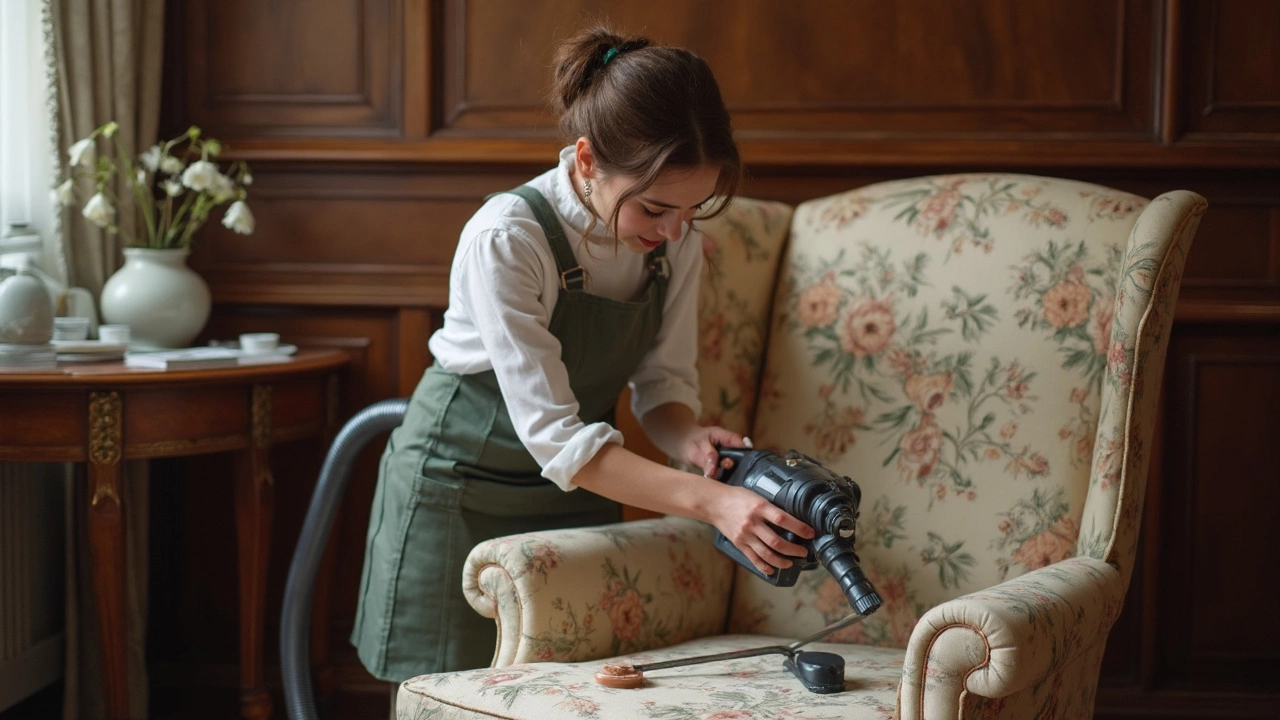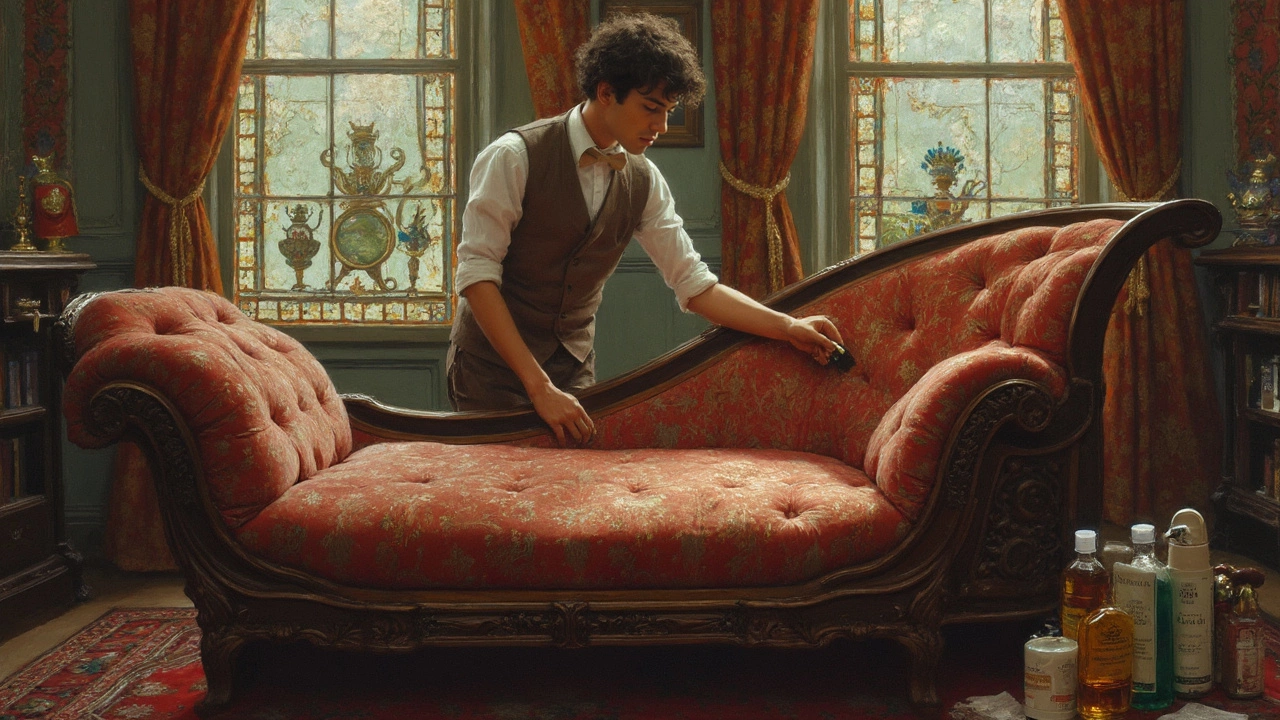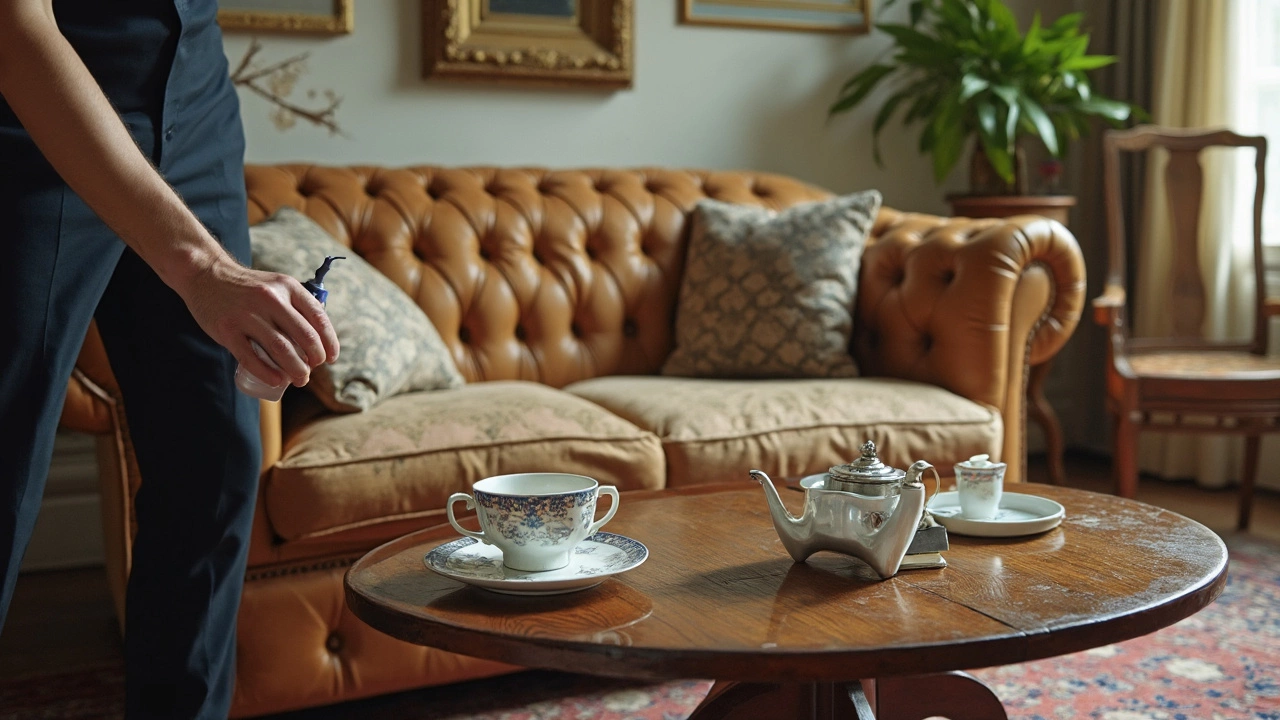Ever faced the headache of stubborn stains on upholstery that can't be tossed in the wash? It's a common issue, and one many of us dread, but fear not! It's entirely possible to keep your non-washable fabric looking great. First, it's crucial to know what you're working with. Upholstery tags can be your best friend here, telling you what's safe and what to dodge. 'W' is good news—water-based cleaners are a go. 'S' means you'll want to stick to solvent-based options, while 'X' is for vacuum and brush only.
Before trying anything else, always give your furniture a good vacuuming first. Dust and crumbs don't stand a chance, and this can actually cut down on needed deeper cleaning. For spot cleaning, homemade solutions come in super handy. A mix of vinegar, water, and a tiny bit of gentle soap can tackle many stains—just do a patch test first! When it comes to stubborn stains, each has its own solution, so patience and the right cleaner will work wonders.
Keeping things fresh is all about regular care. Rotate your cushions and use slipcovers where you can. In the end, a little care goes a long way in upholstery upkeep.
- Understanding Upholstery Labels
- Using Vacuum and Brush Techniques
- Spot Cleaning with Homemade Solutions
- Dealing with Stubborn Stains
- Preventative Care and Maintenance Tips
Understanding Upholstery Labels
Ever puzzled over those little tags on your furniture that seem to have a secret code? They're actually really important when it comes to upholstery cleaning. These labels tell you what kind of cleaning method is safe for your fabric, so let's decode them.
Decoding the Symbols
Most upholstery labels come with a letter code indicating the cleaning method:
- W: Good news! You can use water-based cleaners on this fabric. This makes things relatively easy, as there’s a range of household solutions and commercial products at your disposal.
- S: Solvent-based cleaners are your best bet here. When working with these fabrics, avoid water, as it might cause discoloration or other damage. Always spot-test first!
- W/S: This versatile label means you have the option to use either water-based or solvent-based cleaner. Still, do that patch test to be sure of compatibility.
- X: This one's tricky. Only vacuuming or light brushing is recommended. The fabric could be delicate, so avoid any liquids.
Why These Codes Matter
The last thing you want is to accidentally ruin your sofa because you didn't read the tag. Understanding what the material can handle will save you both time and money. Some fabrics react poorly to certain chemicals, which is why this little piece of information is worth its weight in gold!
By respecting the rules these upholstery labels come with, you extend the life of your furniture. It's essentially a manual on how to use the correct care approach, helping avoid mishaps like shrinkage, color bleeding, or damage.
Next time, before grabbing any old cleaner, check the label—it’s your guide to smoother furniture care!
Using Vacuum and Brush Techniques
Let's dive deep into the nitty-gritty of upholstery cleaning without the hassle of water. Why vacuum, you ask? It's the easiest way to tackle dust, crumbs, and pet hair that love hanging out on your furniture. A regular vacuum routine can save the day by preventing dirt buildup.
Choosing the Right Vacuum Attachment
Not every attachment is created equal. Make sure you have the right tool for the job. Most vacuums come with handy attachments like crevice tools for those tight spots and upholstery brushes that are gentle on fabric yet tough on dirt.
- Crevice Tool: Great for seams and corners where crumbs party hard.
- Upholstery Brush: Soft bristles handle fabric without pulling, perfect for regular maintenance.
Tip: Some people swear by using a lint roller after vacuuming to pick up hard-to-see hair and fibers.
The Art of Brushing
For an extra touch, a soft-bristled brush can help lift dirt buried in the fabric. Just a gentle back and forth can work wonders, especially on plush or napped fabrics.
| Tool | Frequency | Purpose |
|---|---|---|
| Vacuum | Weekly | To remove loose dirt and debris |
| Soft Brush | Monthly | To agitate and lift dirt from fabrics |
Keep this routine up, and watch your sofa shine like new without a drop of water. It's all about being proactive, catching those pesky particles before they invite stains.

Spot Cleaning with Homemade Solutions
Tackling a stain on upholstered furniture that can't be fully washed might feel like a tough gig, but surprisingly, household items can come to the rescue. First things first, you'll want to act fast when a spill happens. The quicker you get to it, the better the outcome. Start by blotting—not rubbing—the area with a clean, dry cloth. This absorbs any excess liquid and stops the stain from spreading.
DIY Cleaning Solutions
Here's where your kitchen cupboard can be useful. For many upholstery cleaning challenges, a simple concoction of ingredients can break down stains effectively:
- Mix equal parts white vinegar and water in a spray bottle. If the fabric can handle it, add a drop of mild dish soap for extra power.
- Spray lightly on the stain. Avoid drenching the area to prevent soaking the padding beneath.
- Blot again with a fresh cloth until the stain lifts. For stubborn spots, repeat as needed.
Vinegar isn't just for fish and chips—it's a mild acid that effectively cuts through grime and dirt. Plus, it's safe for most fabrics.
Targeting Specific Stains
Some stains are trickier than others. Here's how to handle some common offenders:
- Grease: Sprinkle baking soda over the stain and let it sit for 15 minutes to absorb the grease. Then brush it off and treat with the vinegar solution.
- Ink: Dab with a bit of rubbing alcohol on a cotton ball. Be gentle to avoid spreading the ink further.
- Red wine or coffee: A paste of baking soda and water, applied and left to dry, can help lift these pesky spots. Vacuum up the residue once dry.
Safety Tips
While these homemade solutions are handy, always do a patch test on a hidden area of the non-washable fabric before tackling the main stain. It's a simple step that ensures the solution won't damage or discolor your upholstery. And remember, less is more when it comes to applying solutions. Overdoing it can lead to water spots or even shrinkage.
Finally, make necessary adjustments based on the fabric type. For rare or delicate materials, consider consulting a professional to avoid accidental damage.
Dealing with Stubborn Stains
So you've tackled the easy spots, but now you're staring at a stubborn stain on your upholstery that just won't budge. Don't worry—there are ways to handle even the toughest marks. The secret? Knowing your enemy.
Let's break it down by some common culprits:
Oil-Based Stains
Oil stains, like those from food or cosmetics, can feel like a nightmare. Your first line of defense is to absorb as much oil as possible right away. Grab some baking soda or cornstarch, sprinkle it liberally over the stain, and let it sit for about 10-15 minutes. This helps soak up the excess. Then, carefully vacuum it up.
Ink Stains
Ink has a way of sneaking onto our furniture, especially if you have creative kids! Use rubbing alcohol to gently dab the stain. Be cautious, though—no scrubbing, just light blotting. Always do a spot test first in an unseen area.
Red Wine Spills
Nights with friends sometimes get messy. For red wine spills, act fast by blotting (never rubbing) with a paper towel. Then, mix a bit of dishwashing liquid with hydrogen peroxide, dab it carefully, and watch the stain lift. Again, test first to ensure no bleaching.
If all else fails, or if your non-washable fabric requires extra care, you might consider reaching out to a professional cleaner. Especially with delicate or high-value pieces, it's better to be safe than sorry.
And remember, catching stains early is key. Routine checks and quick action can save loads of headache later down the line, keeping your upholstery looking its best.

Preventative Care and Maintenance Tips
Keeping your non-washable upholstery in top shape doesn't have to be a chore if you weave some simple habits into your routine. The key is to stop problems before they start.
Regular Vacuuming
Weekly vacuuming is your upholstery's best defense against dirt. Use a vacuum with a brush attachment to gently lift dirt and dust without damaging the fabric. It takes minutes, but it makes a huge difference in keeping things fresh.
Use Slipcovers
If your furniture allows, invest in slipcovers. They're a practical way to shield your fancy pieces from everyday wear and tear, spills, and stains. Plus, many slipcovers are machine washable, so clean-ups are a breeze!
Rotate Cushions
Rotate and flip your cushions periodically. This helps them wear evenly, preventing one side from looking more worn out than the other. It also keeps cushion filling from sagging, maintaining comfort and appearance.
Limit Sun Exposure
Frequent exposure to sunlight can fade upholstery over time. Whenever possible, position furniture out of direct sun, or use window covers or UV-blocking films.
Regular Spot Checks
Take a few minutes each week to check for any small spots or stains. Addressing them immediately with the appropriate cleaner keeps them from becoming permanent.
Set Up House Rules
If you’ve got kids or pets (we know how it is!), setting some ground rules can save your upholstery. No eating or drinking in certain rooms or keeping pets off furniture might sound harsh, but it preserves your investment.
Prevention might feel like extra work, but trust us—these little steps have a big payoff in how fabulous your furniture looks and lasts.
